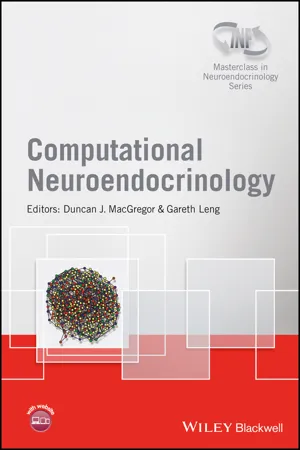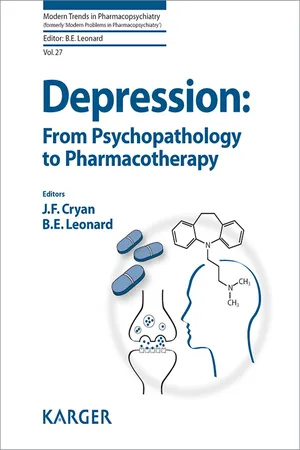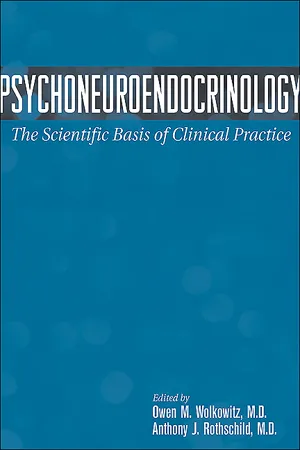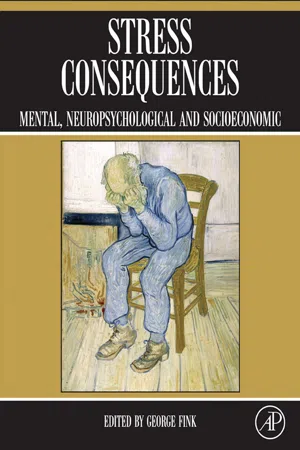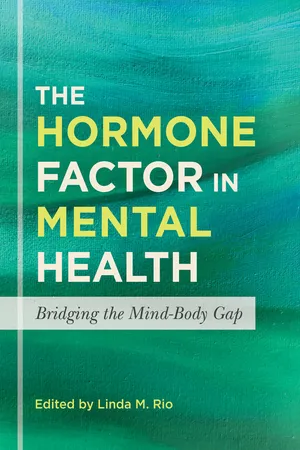Psychology
Hypothalamic-Pituitary-Adrenal System
The Hypothalamic-Pituitary-Adrenal (HPA) system is a key part of the body's stress response. It involves the release of hormones from the hypothalamus, pituitary gland, and adrenal glands, which help regulate various bodily functions in response to stress. Dysregulation of the HPA system has been linked to various psychological and physical health issues.
Written by Perlego with AI-assistance
Related key terms
11 Key excerpts on "Hypothalamic-Pituitary-Adrenal System"
- eBook - ePub
- Duncan J. MacGregor, Gareth Leng(Authors)
- 2016(Publication Date)
- Wiley(Publisher)
Chapter 8 Dynamics of the HPA Axis: A Systems Modeling Approach John R. Terry, Jamie J. Walker, Francesca Spiga and Stafford L. LightmanCollege of Engineering, Mathematics and Physical Sciences* , University of Exeter, Exeter, UKHenry Wellcome Laboratories for Integrative Neuroscience and Endocrinology* , University of Bristol, Whitson Street, Bristol, UKDenotes equal contribution8.1 Introduction
Physical or psychological stress activates autonomic and neuroendocrine pathways leading to downstream physiological processes that enable a rapid and effective response to the threat. This is known as the classic “fight or flight” response and puts the organism in an optimal situation to cope with any challenge to its internal or external environment. One of the most important systems controlling the stress response is the hypothalamic-pituitary-adrenal (HPA) axis, a vital neuroendocrine system that regulates the release of glucocorticoid hormones (cortisol in man, corticosterone in rodents – CORT) from the adrenal glands. Stress-induced changes in circulating CORT levels are a critical component of the body's response to internal or environmental stress, and are important for maintaining homeostasis within the body via regulation of neural, metabolic, immunological, and cardiovascular activity.At the level of the brain, CORT secretion is controlled by the activity of a small cluster of neurons whose cell bodies lie within the paraventricular nucleus (PVN) of the hypothalamus (Figure 8.1 ). The PVN is a highly responsive structure that can detect cognitive or emotional stressors from limbic areas of the central nervous system, such as the amygdala and hippocampus, as well as more physical stressors, such as inflammation or hypotension from brain stem structures (Ulrich-Lai and Herman, 2009). The PVN also receives a major input from the suprachiasmatic nucleus - eBook - ePub
Neurobiology of Bipolar Disorder
Road to Novel Therapeutics
- Joao Quevedo, Andre Ferrer Carvalho, Eduard Vieta, Joao L. de Quevedo(Authors)
- 2020(Publication Date)
- Academic Press(Publisher)
[4] . However, the role and entity of these alterations are yet to be determined, as well as whether the neuroendocrine dysfunction is one of the etiopathogenetic mechanisms behind these disorders or rather one of their manifestations. The aim of this chapter is to summarize literature findings up to date on the association between BD and the HPA axis. Since we will focus specifically on BD patients, the study of this relationship may be further complicated by several characteristics intrinsic to the disease, including the periodic clinical course, the symptomatological heterogeneity, and the obstacles in the diagnosis. We will start with an overview on what the HPA axis is and on its role in the stress response, then we will analyze the link with BD—also from a genetic perspective, finally discussing the potential clinical implications of such relationship.Hypotalamic-pituitary-adrenal (HPA) axis and stress response
The HPA axis is the key hormonal mediator of the stress response. In stressful situations, cortical and subcortical centers modulate the activation of the paraventricular nucleus of the hypothalamus, which stimulates several neuroendocrine reactions, vital for the maintenance of homeostasis. The activation of the paraventricular nucleus (PVN) of the hypothalamus induces the release, among others, of corticotropin releasing hormone (CRH) in the pituitary portal system. CRH reaches the anterior pituitary gland and then stimulates the corticotropic cells to produce the prohormone proopiomelanocortin (POMC), which is cleaved to yield different peptides, including beta-endorphin, and the peptide hormones lipotropin, melanocyte-stimulating hormone, and adrenocorticotropic hormone (ACTH). ACTH is released from the pituitary gland in the systemic circle and reaches the adrenal cortex where it induces the production and secretion of glucocorticoids (GCs), mainly cortisol in humans. Plasma cortisol levels have a circadian rhythm that follows the secretion of ACTH, with the zenith in the morning (around 7 a.m.), a preprandial secretory peak, and an evening nadir (toward 8 p.m.). - J. F. Cryan, B. E. Leonard(Authors)
- 2010(Publication Date)
- S. Karger(Publisher)
Basic and Clinical Aspects of Depression Research Cryan JF, Leonard BE (eds): Depression: From Psychopathology to Pharmacotherapy.Mod Trends Pharmacopsychiatry. Basel, Karger, 2010, vol 27, pp 20-31 ______________________The Hypothalamic-Pituitary-Adrenal Axis in Depression
Marcela Julio-Piepera · Timothy G. Dinanba Laboratory of Neurogastroenterology, Alimentary Pharmabiotic Centre, and b Department of Psychiatry, University College Cork, Cork, Ireland______________________Abstract
The hypothalamic-pituitary-adrenal (HPA) axis is the core endocrine stress system in humans. While corticotropin-releasing hormone (CRH) and vasopressin are the major secretagogue peptides of the HPA axis/stress system, glucocorticoids play a pivotal feedback role in the regulation of the HPA axis. Both the peak and the nadir in circulating cortisol concentrations are elevated in depression, but overall there is little reduction in amplitude of the circadian rhythm and neither is its timing significantly shifted. CRH has been administered following pretreatment with dexamethasone, which results in augmented adrenocorticotropic hormone and cortisol responses in depressed patients compared to normal controls. Studies have also shown that women who were sexually or physically abused in childhood exhibit a markedly enhanced activation of the HPA axis. To date, most large-scale studies of compounds targeting the HPA axis have produced disappointing results. Whether or not the HPA axis is an appropriate target for novel antidepressants has yet to be convincingly demonstrated.Copyright © 2010 S. Karger AG, BaselWhile acute stress activates the sympathoadrenal medullary system resulting in the components of the ‘fight or flight’ response with a release of catecholamines, chronic stress results in alterations of the hypothalamic-pituitary-adrenal (HPA) axis with an increase in the release of cortisol. The HPA axis is the core endocrine stress system in humans [1 ]. It not only regulates the body’s peripheral functions relating to metabolism and immunity but has also profound effects on the brain by regulating neuronal survival and neurogenesis in structures such as the hippocampus where it plays a role in memory [2- eBook - ePub
- F. Robert Brush, Seymour Levine(Authors)
- 2013(Publication Date)
- Academic Press(Publisher)
CHAPTER SEVENPsychoneuroendocrinology of Stress: A Psychobiological Perspective
Seymour Levine, Christopher Coe and Sandra G. WienerPublisher Summary
This chapter discusses specific psychological variables that are involved in the regulation of the Pituitary–Adrenal (P–A) activity and specific aspects of the psychological variables that can selectively affect and regulate the secretion of gonadal hormones. The influence of psychological factors on P–A hormones is bidirectional. The psychological stimuli not only participate in activating this system but also effectively inhibit it. This inhibition is manifested either by reduced elevations of plasma corticoids during aversive stimulation or by an actual decrease in circulating levels of corticoids. This effect is particularly pronounced when the predictable or reinforcing stimulus involves consummatory events. Apart from induced stress, feedback is another factor involved in this process. Feedback refers to stimuli or information occurring after a behavioral response has been made in reaction to an event. These stimuli may be used to convey information to the responding organism indicating that it has made the correct response to a noxious event. The field of neuroendocrinology has made tremendous advances in the past few decades in identifying many chemical substances that qualify as hormones not only in the pituitary and peripheral organs but also in the central nervous system.I Introduction
Despite numerous and valiant attempts to define stress, a clear and universally accepted definition still remains, to say the least, elusive. It is not the purpose of this chapter, therefore, to dwell extensively on the problems related to the definition of stress. This would be an exercise in futility. It is important to note, however, that historically the concept of stress has always been associated with changes in the endocrine system. Initially, these changes were specifically related to either increased secretion of catecholamines or activation of the pituitary–adrenal (P–A) system. It has now been clearly demonstrated that many endocrine changes occur following those environmental events which are typically called stressful. The focus of a great deal of research related to stress physiology is still on the P–A system. It is, of course, impossible to discuss any facet of the P–A system and its relationship to environmental factors without acknowledging the landmark contributions of Hans Selye. His formulation of the General Adaptation Syndrome (GAS) highlighted the importance of this hormonal system and the diversive physiological effects of glucocorticoids following adverse stimulation (Selye, 1950 - eBook - ePub
Environmental Illness
Myth & Reality
- Herman Staudenmayer(Author)
- 2018(Publication Date)
- Routledge(Publisher)
The stress-response can account for multi-system complaints (Rose, 1980) and has been proposed as one psychogenic theory (Jewett, 1992a). This chapter focuses on central nervous system (CNS) complaints: difficulty concentrating, attentional difficulties, memory loss or poor memory, learning difficulties (inappropriately portrayed as dyslexia), difficulty expressing oneself or understanding others (portrayed as aphasia), feelings of being out of touch, depersonalization or derealization, fatigue, and irritability. These symptoms are what EI patients refer to collectively as “brain fog” or “brain fag”. They are mediated by disturbances of central neuronal pathways that regulate arousal, alertness, and vigilance, which in turn modulate the general capacity and effectiveness of cognitive processing involved in learning and memory (Craik and Lockhart, 1972; Ellis et al., 1984). These symptoms are also on the menu of criteria that define anxiety disorders, particularly panic attacks in DSM-IV.Chrousos and Gold (1992) described the three main physiologic systems involved in the stress-response: 1. Corticotropin-releasing hormone (CRH), which affects the brain directly and also initiates a cascade of responses along the hypothalamic-pituitary-adrenal (HPA) axis 2. Norepinephrine (NE) systems associated with the locus coeruleus (LC) referred to as LC-NE 3. Autonomic nervous system (ANS), primarily the sympathetic branch.These three systems interact with inhibitory neurotransmitter systems to dampen the stress-response (Figure 9.1 ). They also interact with the endocrine and immune systems to create organ-specific and systemic effects. Each of these systems is defined with discussion focused on the stress-responses consistent with multi-system complaints seen in EI patients.Hypothalamic-pituitary-adrenal axisThe HPA axis is the major neuroendocrine stress regulatory system in the body (Krishnan et al., 1991). Its clinical manifestations vary, depending on the extent and severity of the pituitary hormone deficiency and the specific organs targeted by the endocrine mediators. In the extreme, hypopituitarism may result from either pituitary or hypothalamic disease (Vance, 1994). Of note, dysregulation of the HPA-axis may result in nonspecific symptoms of fatigue and malaise.Corticotropin-releasing hormone (CRH) is a hypothalamic peptide widespread throughout the brain but best characterized in the hypothalamus, specifically in the paraventricular nucleus (PVN). In animal studies, exogenous stimulation with CRH has been associated with hypercortisolism, sympathetic activation, and behavioral activation and intense arousal (Sutton et al., 1982). Larger doses of CRH administered directly to the CNS produce effects that can be construed as frankly anxiogenic. This includes hyperresponsiveness to sensory stimuli, assumption of the freeze posture, decreased exploration in unfamiliar environments (avoidance), and enhancement of conditioned fear responses during aversive stimuli (Dunn and Berridge, 1990). In humans, parallel symptoms are defining of post-traumatic stress disorder (PTSD). For example, Vietnam combat veterans with PTSD have been found to have higher concentrations of cerebral spinal fluid CRH (Bremner et al., 1997). - eBook - ePub
- Simon Greene(Author)
- 2013(Publication Date)
- Psychology Press(Publisher)
As I pointed out at the beginning of this chapter, psychology has found emotion an elusive topic to study. Even today there is no agreed definition of the term, and at least 30 current models. Research on the central and peripheral biological mechanisms has clarified some issues, and led to systematic and inventive experiments. We can make some general statements, but detailed psychobiological models will have to wait until we have a psychological analysis of emotional experience and behaviour that we can all accept.Summary: Stress, Anxiety, and Emotion- Stress exists when there is a mismatch between perceived demands and perceived coping ability. It can be energising, but long-term chronic stress can also lead to psychological and physiological problems.
- The adrenal gland plays a central role in the physiological responses to stressors. The adrenal cortex releases corticosteroids in response to the hormone ACTH which is secreted from the pituitary gland. As the pituitary is in turn controlled by the hypothalamus, this chain is known as the hypothalamic-pituitary--adrenal axis.
- In stressful situations the autonomic nervous system (ANS) activates the adrenal medulla, which releases adrenaline and noradrenaline into the bloodstream. General ANS activation and the release of hormones from the adrenal gland produces a pattern of peripheral arousal in the body. If the stressor is short-lasting, the arousal fades away; its basic purpose is to supply the energy needs involved in behavioural coping responses.
- Selye identified the General Adaptation Syndrome. Physiological stress responses go through stages of alarm, resistance, and exhaustion when confronted by chronic stressful situations.
- Coping responses to modern day stressors do not always involve physical activity, and the physiological arousal found in these situations therefore becomes maladaptive and can lead to psychosomatic disorders.
- The work of Brady and Weiss with animals has shown that physical reactions to stressors are influenced by individual differences and by feedback on successful coping behaviour.
- Frankenhaeuser demonstrated that adrenaline release is sensitive to any arousing stimulation. Males show a more vigorous adrenaline release than females in stressful situations, although this may not apply to females in non-sex role stereotyped roles.
- eBook - ePub
Psychoneuroendocrinology
The Scientific Basis of Clinical Practice
- Owen M. Wolkowitz, Anthony J. Rothschild(Authors)
- 2008(Publication Date)
- American Psychiatric Association Publishing(Publisher)
The HPA axis regulates glucocorticoid production and release. In addition to the hypothalamus and the pituitary and adrenal glands, its activity involves a complex set of interrelated feedback loops, including elements of the immune system, the limbic areas of the brain, and the locus coeruleus. Stress responses are mediated through the HPA axis initially by the release of corticotropin-releasing hormone (CRH), a 41–amino acid peptide, synthesized in the parvocellular cells of the paraventricular nucleus of the hypothalamus. It is released into the hypophyseal portal blood of the median eminence and is transported to the anterior lobe of the pituitary. Although relatively little is known about the determinants of extrahypothalamic CRH secretion, the regulation of CRH secretion by the hypothalamus is becoming increasingly well understood. Preclinical studies in rats have shown that the neurotransmitters norepinephrine, acetylcholine, and serotonin stimulate the release of CRH (Calogero et al. 1988a, 1988b, 1989), as do the cytokines interleukin-1 and interleukin-6 (Naitoh et al. 1988; Sapolsky et al. 1987).CRH is not the only neuropeptide that stimulates pituitary adrenal activation. The hypothalamus also produces and secretes a second important stimulant of glucocorticoid secretion, the 9–amino acid peptide arginine vasopressin (AVP). Most hypothalamic AVP is produced in the magnocellular region and is transported to the posterior pituitary to be released as an element active in maintaining fluid and volume balance by conserving free water. However, AVP is also produced in smaller amounts in the parvocellular region of the hypothalamus, and, like CRH, it acts at the anterior pituitary to induce the release of adrenocorticotropic hormone (ACTH) (Salata et al. 1988). Compared with CRH, AVP is a relatively weak secretagogue of ACTH; however in the presence of CRH AVP has a powerful synergistic effect that causes greater ACTH release than either AVP or CRH alone can induce (DeBold et al. 1984). AVP-induced ACTH secretion may not be glucocorticoid suppressible (Bilezikjian et al. 1987), and this may permit AVP to play an important role in the maintenance of chronic stress responses. - eBook - ePub
Cell Biology Assays
Essential Methods
- Fanny Jaulin, Cedric Espenel(Authors)
- 2009(Publication Date)
- Academic Press(Publisher)
General endocrinology . Philadelphia: W. B. Saunders.Watts, A. G. (2005). Glucocorticoid regulation of peptide genes in neuroendocrine CRH neurons: a complexity beyond negative feedback. Frontiers in Neuroendocrinology 26 , 109–130.Passage contains an image
Feedback Systems
G Fink Mental Health Research Institute, Parkville, Victoria, Australia© 2007 Elsevier Inc. All rights reserved. This is a revised version of the article by G Fink, Encyclopedia of Stress, First edition, volume 2, pp 124–137, © 2000, Elsevier Inc.Glossary
Allostasis Maintaining stability (or homeostasis) through change; term introduced by Sterling and Eyer in 1988 to describe cardiovascular adjustments to resting and active states. Homeostasis The maintenance of equilibrium, or constant conditions, in a biological system by means of automatic mechanisms (generally feedback systems) that counteract influences (stressors) that tend toward disequilibrium (term introduced by Walter Cannon in 1932).Hypercortisolemia Excessively high concentrations of adrenal corticosteroids in plasma. Hypophysial portal vessels A group of small venules that connect a primary plexus of capillaries in the median eminence of the hypothalamus (base of the brain) with a secondary plexus of sinusoids in the pituitary gland. Blood flowing in these vessels, which run down the pituitary stalk, transports hypothalamic-pituitary regulatory neurohormones, released at nerve terminals in the median eminence of the hypothalamus, to the anterior pituitary gland, where they stimulate or inhibit the release of anterior pituitary hormones.Limbic system An extensive brain region that includes the cingulate and parahippocampal cortex, hippocampus, amygdala, hypothalamus, septal nuclei, and other structures. The precise interaction of the several components of the system is poorly understood, but since the proposal by Papez, the limbic system has been implicated in emotion. The connections between the limbic system and the neocortex, hypothalamus, and the olfactory bulb via the olfactory tract suggest that it serves as an important analyzer-integrator of signals, which it conveys from the neocortex to the hypothalamus. The input of olfactory information to the limbic system has led to its alternative name, the rhinencephalon (olfactory brain), and possibly reflects the strong emotive and signaling effects of smell in many animals. The structure and relative size of the limbic system have remained remarkably constant through evolution; in humans it is overshadowed by the massive development of the neocortex. - Oliver C. Schultheiss, Pranjal H. Mehta(Authors)
- 2018(Publication Date)
- Routledge(Publisher)
Meanwhile, there is clear evidence for a causal role of stress in the genesis, development, and progression of numerous diseases. Simultaneously, evidence has accumulated that shows that HPA axis responses to acute stress are altered in clinical populations encompassing various somatic as well as psychiatric diseases (Chrousos, 2009; Kudielka & Wüst, 2010). Detailed summaries and meta-analysis can be found elsewhere, as for somatic illnesses (Strahler, Skoluda, Rohleder, & Nater, 2016); autoimmune disorders (Buske-Kirschbaum, Geiben, Höllig, Morschhäuser, & Hellhammer, 2002; Tsigos & Chrousos, 1994); psychiatric diseases including depression, schizophrenia, posttraumatic stress disorder, anxiety and panic disorders etc. (Bradley & Dinan, 2010; Burke, Davis, Otte, & Mohr, 2005; Ciufolini, Dazzan, Kempton, Pariante, & Mondelli, 2014; Knorr, Vinberg, Kessing, & Wetterslev, 2010; Zorn et al., 2016); or, in particular, health and disease in children ( Jessop & Turner-Cobb, 2008). From a mechanistic point of view, it is not always clear whether HPA axis alterations lead to health impairments, if an illness leads to altered HPA axis alterations, or both. In any case, in non-clinical studies, subjects should carefully be screened for health impairments and respective exclusion criteria should be established defining study eligibility.4.9 Methodological issues
Finally, some methodological issues, like habituation, time of testing (additional) collection of blood samples, anticipation effects, and the concomitant assessment of stress appraisal and inter-laboratory effects need to be briefly discussed.A prominent feature of HPA axis responses to acute psychosocial stress is its strong habituation over repeated exposures (Pruessner et al., 1997; Schommer, Wiemers, & Wolf, 2003; Federenko, Wüst, et al., 2004). In this regard, the HPA axis is different from the sympathetic nervous, immune, and blood coagulation system, as well as indices of hemoconcentration, which all show rather uniform activation patterns after repeated stress exposures (see Kudielka et al., 2009). In more detail, Wüst, Federenko, van Rossum, Koper, and Hellhammer (2005) reported a substantial variability of salivary cortisol response habituation patterns in healthy individuals. While 52% of the participants showed the well-known response habituation across three TSST test sessions (indicated by a response reduction across TSST exposures), 30% did not show an obvious response alteration and almost 16% of participants showed a response sensitization (indicated by a response increase across testings). The authors speculated that the specific habituation of the HPA axis to psychosocial stress is due to a reduction in context variables across sessions due to the decreasing experience of task novelty, unpredictability, and uncontrollability by subjects (Kudielka et al., 2009; Wüst, Federenko, et al., 2005). From a methodological point of view, due to such habituation effects, a within-subjects design with repeated pre- and post-interventional TSST exposure does not qualify as valid proof of stress-reducing effects of a given treatment on acute HPA axis stress regulation (e.g., psychotherapy, stress management training, etc.) since it would remain unclear whether the treatment or the familiarization with the TSST exposure had caused a potential stress response reduction. However, when planning studies with repeated exposition to the TSST, pure habituation effects might potentially be prevented, or at least be minimized, with large enough between-trial intervals and changing test settings (see Foley & Kirschbaum, 2010). Having said that, the repeated exposure to the same stressor can help to unveil associations with factors that might be otherwise overlooked at first testing, like personality traits (Pruessner et al., 1997), effects of genetic make-up (Federenko, Wüst, et al., 2004), or work-related exhaustion (Kudielka, von Känel, et al., 2006).- eBook - ePub
Stress Consequences
Mental, Neuropsychological and Socioeconomic
- George Fink(Author)
- 2010(Publication Date)
- Academic Press(Publisher)
During stress, adaptive behavioral and peripheral responses are activated that optimize the ability of the organism to adjust homeostasis. Stress is associated with increased activity of the HPA axis and the LC-NE-SNS, which result in systemic elevations of their endocrine end-effectors, the glucocorticoids (cortisol) and the catecholamines (CAs). These compounds, together with other products of the stress system, such as for instance the cytokine interleukin (IL)-6, influence a variety of adaptive responses. The activation of the HPA axis is regulated by glucocorticoid negative-feedback control through glucocorticoid receptors (GR) in the central nervous system (CNS). Normally, there is a diurnal secretory pattern of cortisol with elevations in the early morning and decreases in the afternoon and evening hours. This basal activity is modified by stressful stimuli, which can be either physical (extreme environmental alteration, trauma, and toxins) and/or events that are perceived as unpleasant, demanding, scary, or threatening. The latter can include recalls of previously experienced or unpleasant or pleasant events which either positively or negatively influence the regulation of the HPA axis. Thus, stress leads to increased integrated cortisol and CA secretion, which can be of short or long duration depending on the severity and duration of the stressor. Following repeated exposure to stressors there is great interindividual variation in the extent of cortisol response habituation. Although studies have been conflicting with some showing activation and others attenuation of the HPA axis function in chronic stress, in both situations abnormalities of cortisol secretory dynamics are evident defining a chronic hyperactivation or hypoactivation of the stress system. - eBook - ePub
The Hormone Factor in Mental Health
Bridging the Mind-Body Gap
- Linda M. Rio(Author)
- 2013(Publication Date)
- Jessica Kingsley Publishers(Publisher)
The female reproductive system is regulated by the hypothalamic–pituitary–ovarian (HPO) axis. Neurons located primarily in the hypothalamic preoptic and arcuate nuclei secrete gonadotropin-releasing hormone (GnRH) into hypophyseal portal system in a pulsatile manner. In the adenohypophysis, GnRH stimulates gonadotroph production of FSH (follicle-stimulating hormone) and LH (luteinizing hormone), which then activate the ovary to secrete estradiol (E2) and progesterone. Interactions between the HPO and stress axes are illustrated.In women, these effects of the HPA axis are responsible for the hypothalamic amenorrhea of stress, a condition which is observed in anxiety and depression, eating disorders and chronic excessive exercise and the hypogonadism of Cushing’s syndrome. In men, these changes of HPA axis function result in decreased libido and hypofertility. It is important to note that apart from stress-induced testosterone decrease, direct effects of stress on the seminiferous epithelium have also been reported (Kalantaridou e t al. , 2010).Epidemiologic and experimental studies suggest that adverse intrauterine stressors such as abnormal trophoblast invasion, deficient remodeling of spiral arteries with high-resistance placental vessels, and subsequent placental dysfunction may lead to preterm labor, fetal growth restriction, and pre-eclampsia. Notably, all the above conditions are characterized by increased levels of CRH in maternal circulation and in the fetus; however, it remains to be elucidated whether this increase is causally related or is a consequence of an underlying pathophysiology. In addition to elevated CRH levels, abnormal increases in fetal cortisol have also been recognized as predisposing to later life diseases, such as insulin resistance, cardiovascular diseases, and psychiatric disorders (Cottrell & Seckl, 2009). Apart from the adverse intrauterine stressors, maternal prenatal stress, anxiety, and depression may affect fetal programming, by being associated with the manifestation of adult offspring long-term diseases, such as diabetes mellitus type 2, cardiovascular disease, and neurodevelopmental disorders (Nolan, Damm, & Prentki, 2011; Sandman et al. , 2011; van Dijk et al. , 2012). It is of note that animal studies have indicated that these outcomes may vary according to the strain, gender, type, and duration of maternal stress. Stress during pregnancy can impair biological and behavioral responses (Garcia-Caceres et al. , 2010). Pregnancy in the third trimester by itself is a condition characterized by hypercortisolism of a degree similar to that observed in severe depression, anorexia nervosa, and mild Cushing’s syndrome and is the only known physiological state in humans in which CRH circulates in plasma at levels high enough to cause activation of the HPA axis (Chrousos et al. , 1998). Although circulating CRH, which is placental in origin, is bound with high affinity to CRH-binding protein (Linton et al. , 1993), it appears that the circulating free fraction is sufficient to explain the observed escalating hypercortisolism when the plasma concentrations of CRH-binding protein starts to gradually decrease in plasma after the 35th week of pregnancy. Interestingly, maternal gestational stress may also lead to low birth weight (Kinsella & Monk, 2009), which in turn has been correlated with adult increased plasma cortisol levels and risk for developing metabolic syndrome (Chrousos & Kino, 2007).
Index pages curate the most relevant extracts from our library of academic textbooks. They’ve been created using an in-house natural language model (NLM), each adding context and meaning to key research topics.
